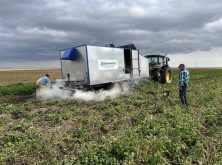Dealing with resistant weeds is a little like dealing with alcoholism, according to a Nufarm executive. The first step is to acknowledge that you’ve got a problem.
Lachie McKinnon heads North American business development for Nufarm, and is also the Canadian manager. McKinnon shared thoughts on managing herbicide resistance based on his experience working in the ag industry in Australia during a plot tour at Ag-Quest, west of Saskatoon.
Herbicide resistance was confirmed in Australia in the ’80s, McKinnon said, but herbicide-resistant weeds were probably present before that. But, he added, “the denial from growers, from industry, even from chemical companies, dare I say, was quite remarkable.”
Read Also

Claas brings 1000 Series SP forage harvesters to Canada
In mid-August, Claas unveiled its new line of Jaguar forage harvesters at an event in Visalia, California, deep in the heart of that state’s dairy region.
That denial led to bigger problems than if they’d accepted and addressed herbicide resistance earlier, McKinnon added. It’s a mistake many hope to avoid in Western Canada.
McKinnon acknowledged that Nufarm doesn’t have all the solutions. In fact, “if any one particular group in the industry thinks they do have all the solutions, they’re misguided,” he said.
In an effort to delay resistance, Nufarm is working with other companies to offer more herbicide solutions to farmers. For example, Nufarm and Monsanto offer a rewards program, dubbed Real Farm Rewards, to encourage canola growers to use multiple modes of action.
Nufarm and Gowan have also teamed up to share information on slowing resistance.
“If the information and training our companies are sharing with growers and agronomists are similar it will help to cut down some of the confusing and sometimes conflicting messages in the industry,” said Graham Collier, technical services manager for Nufarm.
Resistance spreading in Western Canada
Hugh Beckie, research scientist with Agriculture and Agri-Food Canada in Saskatoon, was also on-hand to talk resistance. The latest herbicide-resistant weed survey in Saskatchewan, conducted by Beckie, Scott Shirriff, and Julie Leeson, found that 57 per cent of 400 surveyed fields had weeds resistant to one or more herbicide groups. The previous weed survey, in 2009, found 31 per cent of surveyed fields in Saskatchewan had resistant weeds.
Beckie wasn’t entirely surprised by the Saskatchewan weed survey, as 60 per cent of surveyed fields in Manitoba had resistance. Beckie and his colleagues will be surveying Alberta fields in 2017, and he expects to find resistance in over 30 per cent of surveyed fields.
Beckie told reporters there are several factors behind herbicide resistance. Historically, farmers sprayed in mid-June each year. Often farmers used the same mode of action in the same field year after year, until they ran into problems. Farmers inadvertently selected weeds that adapted to those herbicides and routines.
But despite the growing number of resistant weeds, Beckie is optimistic.
“By and large, growers are still managing their resistance fairly well because if you look at the weed population densities in the summer and fall, they really haven’t dramatically increased over that last 20 years or so.”
Those low population densities mean farmers are doing something right, he added.
“They may have to apply another herbicide to control that resistant population, but they’re doing the best they can, I think, to keep the weed population under control so that it doesn’t negatively impact either yield or quality.”
The weed survey also questioned 250 Saskatchewan farmers on how they manage weeds. Farmers have already adapted many of the recommended management practices, Beckie said. For example, farmers with confirmed or suspected resistance favoured crop rotation, tank mixes, herbicide group rotation, and pre-emergent herbicides to manage the problem. They were also more likely to scout before applying in-crop herbicide, increase seeding rates, and grow more competitive crops.
“So they actually are listening to people like us who have been talking about this for 30 years,” said Beckie.
Managing resistance is for everyone
Beckie sported a NASA cap, which he picked up at Cape Kennedy. But the NASA hat’s purpose went beyond fashionable sun protection.
“Weed resistance isn’t rocket science,” said Beckie. “It’s within the grasp of everyone in this industry to manage it and manage it well.”
For a time, farmers were advised to rotate their chemical groups each year. Beckie says research now shows that using multiple modes of action simultaneously is more effective.
Collier said tank mixes also help protect each mode of action before resistance appears. However, Collier said it’s important to make sure weeds aren’t already resistant to any of the modes of action when using tank mixes.
Farmers who suspect resistant weeds can send samples to labs for screening. If farmers suspect Group 4 or Group 9 resistance, they should report the weeds as soon as possible, Collier said.
Farmers can also apply herbicides during different windows: pre-seed burndown, in-crop, pre-harvest, and post-harvest. Varying other agronomic practices, such as seeding date, can also make it harder for weeds to adapt.
“Diversity is always the buzz word in terms of weed resistance management,” said Beckie. “That applies to both herbicides and other agronomic practices.”
Beckie said there is no silver bullet. “I tell growers that they have to keep using the tools that they have, but use them as wisely as they can. And just keep the good ones in reserve whenever you can.”
















